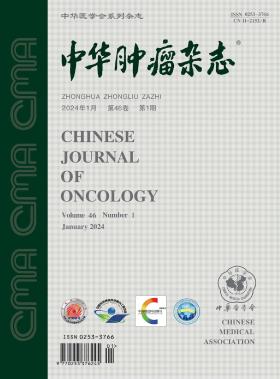[Artemin通过PI3K/Akt通路促进周围神经鞘恶性肿瘤细胞的增殖和侵袭]。
摘要
目的:探讨Artemin (ARTN)在恶性周围神经鞘肿瘤(MPNST)中的表达、对MPNST细胞恶性行为的影响及其信号通路。方法:收集1995年1月至2011年11月天津医科大学肿瘤医院手术切除的51例MPNST石蜡包埋组织,采用免疫组化方法检测ARTN蛋白表达,分析ARTN蛋白表达与临床病理特征及预后的关系。在人MPNST细胞株ST-8814 (NF-1)和STS26T(散发性)中,分别转染ARTN过表达质粒和ARTN小干扰RNA (siRNA)构建ARTN过表达细胞株和低表达细胞株。采用实时定量聚合酶链反应(RT-qPCR)检测ARTN mRNA的表达,Western blot检测ARTN蛋白及PI3K /Akt信号通路相关蛋白的表达。采用CCK-8法检测细胞增殖能力,采用细胞侵袭法检测细胞侵袭能力。在STRING数据库中搜索与ARTN相互作用的途径蛋白,并通过京都基因与基因组百科全书(KEGG)富集分析明确其功能途径。采用PI3K/Akt通路特异性抑制剂LY294002阻断ST-8814和STS26T细胞的PI3K/Akt通路,观察细胞增殖和侵袭的变化。结果:51例MPNST组织标本中,ARTN蛋白高表达22例,低表达29例。ARTN蛋白的高表达与肿瘤直径增大和疾病进展(复发或转移)相关(P<0.05)。ARTN蛋白低表达患者的中位无病生存期(DFS)为26.2个月,中位总生存期(OS)为66.9个月。ARTN蛋白高表达患者的中位DFS和中位OS分别为10.7个月和53.8个月。log rank检验结果显示,ARTN蛋白高表达患者的无进展生存率较低表达患者差(P=0.027),但两组总生存率差异无统计学意义(P=0.790), Cox回归分析也证实了这一点。CCK-8检测结果显示,转染48h后,ARTN过表达组ST-8814和STS26T细胞的吸光度(A)值分别为1.35±0.01和1.10±0.02,均高于空质粒对照组(1.05±0.01和0.78±0.01,P均<0.01),而ARTN siRNA组ST-8814和STS26T细胞的A值分别为0.35±0.01和0.61±0.01,均低于对照siRNA组(0.74±0.01和1.10±0.04)。P < 0.01)。细胞侵袭实验结果显示,过表达ARTN的ST-8814和STS26T细胞的跨膜细胞数分别为(29.67±2.08)和(31.67±2.08)个,高于空质粒对照组的(20.00±1.00)和(24.33±1.15)个,P均<0.01。ARTN siRNA组ST-8814和STS26T细胞跨膜细胞数分别为(14.00±2.00)个和(19.33±1.53)个,低于对照siRNA组(19.33±2.52)个和(23.33±0.58)个,P均<0.05。KEGG结果显示,ARTN与多种肿瘤信号通路相关,尤其是PI3K/Akt信号通路。Western blot结果显示,过表达ARTN可上调ST-8814和STS26T细胞中P - pi3k和P - akt蛋白的表达(P<0.01)。敲低ARTN表达后,P - pi3k和P - akt蛋白表达显著下调(P<0.01)。LY294002阻断PI3K/Akt通路后,可显著抑制ARTN过表达对ST-8814和STS26T细胞的影响。ARTN过表达+LY294002组ST-8814和STS26T细胞的A值分别为1.09±0.06和0.82±0.01,低于ARTN过表达组(分别为1.50±0.01和1.29±0.01,P均<0.01)。细胞侵袭组跨膜细胞数分别为16.67±3.21个、19.67±2.31个,低于过表达组(29.67±2.08个、31.67±2.08个,P均<0.01)。结论:在MPNST中,ARTN蛋白的高表达与更大的肿瘤大小、疾病进展和更差的DFS相关。ARTN通过PI3K/Akt信号通路促进MPNST细胞的增殖和侵袭。Objective: To investigate the expression of Artemin (ARTN) in malignant peripheral nerve sheath tumor (MPNST), its effect on the malignant behavior of MPNST cells, and its signaling pathway. Methods: Fifty-one MPNST paraffin embedded tissues through surgical resection at Tianjin Medical University Cancer Hospital from January 1995 to November 2011 were collected, the expression of the ARTN protein was detected by immunohistochemistry, and the relationship between the ARTN protein expression and the clinical pathological characteristics and prognosis were analyzed. In human MPNST cell lines ST-8814 (NF-1) and STS26T(sporadic), ARTN overexpression and low expression cell lines were constructed by transfecting ARTN overexpression plasmids and ARTN small interfering RNA (siRNA), respectively. The expression of ARTN mRNA was detected by real time quantitative polymerase chain reaction (RT-qPCR), the expression of the ARTN protein and Phosphoinositide 3-kinase(PI3K)/Akt signaling pathway related proteins were detected by Western blot. CCK-8 assay was used to detect cell proliferation ability, and cell invasion assay was used to detect cell invasion ability. The pathway proteins that interacted with ARTN were searched in the STRING database, and the functional pathways were clarified by Kyoto Encyclopedia of Genes and Genomes (KEGG) enrichment analysis. The PI3K/Akt pathway specific inhibitor LY294002 was used to block the PI3K/Akt pathway of ST-8814 and STS26T cells to observe the changes in cell proliferation and invasion. Results: Among the 51 MPNST tissue specimens, 22 cases showed a high expression of the ARTN protein and 29 cases showed a low expression of the protein. Higher expressions of the ARTN protein was associated with larger tumor diameters and disease progression (recurrence or metastasis) (both P<0.05). The median disease-free survival (DFS) of patients with a low expression of the ARTN protein was 26.2 months, and the median overall survival (OS) was 66.9 months. The median DFS and median OS of patients with a high expression of the ARTN protein were 10.7 months and 53.8 months, respectively. The log rank test results showed that the progression free survival rate of patients with a high expression of the ARTN protein was worse than that of patients with a low expression (P=0.027), but the difference in overall survival rate between the two groups was not statistically significant (P=0.790), which was also confirmed by Cox regression analysis. The CCK-8 assay results showed that after 48 hours of transfection, the absorbance (A) values of ST-8814 and STS26T cells in the ARTN overexpression group were 1.35±0.01 and 1.10±0.02, respectively, which were higher than those in the empty plasmid control group (1.05±0.01 and 0.78±0.01, both P<0.01), while the A values of ST-8814 and STS26T cells in the ARTN siRNA group were 0.35±0.01 and 0.61±0.01, respectively, which were lower than those in the control siRNA group (0.74±0.01 and 1.10±0.04, both P<0.01). The results of cell invasion assay showed that the number of transmembrane cells in ST-8814 and STS26T cells overexpressing ARTN was (29.67±2.08) and (31.67±2.08), respectively, which were higher than those in the empty plasmid control group [(20.00±1.00) and (24.33±1.15), both P<0.01]. The number of transmembrane cells in ST-8814 and STS26T cells in the ARTN siRNA group were (14.00±2.00) and (19.33±1.53), respectively, which were lower than those in the control siRNA group [(19.33±2.52) and (23.33±0.58), both P<0.05].The KEGG results showed that ARTN is associated with multiple tumor signaling pathways, especially the PI3K/Akt signaling pathway. Western blot results showed that overexpression of ARTN upregulated the expression of p-PI3K and p-Akt proteins in ST-8814 and STS26T cells (both P<0.01).After knocking down ARTN expression, the expression of p-PI3K and p-Akt proteins was significantly down regulated (both P<0.01). LY294002 could significantly inhibit the effect of ARTN overexpression on ST-8814 and STS26T cells after blocking the PI3K/Akt pathway. The A values of ST-8814 and STS26T cells in the ARTN overexpression+LY294002 group were 1.09±0.06 and 0.82±0.01, respectively, which were lower than those in the ARTN overexpression group (1.50±0.01 and 1.29±0.01, respectively, both P<0.01). The numbers of transmembrane cells in the cell invasion assay were 16.67±3.21 and 19.67±2.31, respectively, which were also lower than those in the ARTN overexpression group (29.67±2.08 and 31.67±2.08, respectively, both P<0.01). Conclusions: In MPNST, a high expression of the ARTN protein was associated with larger tumor size, disease progression, and worse DFS. ARTN promotes the proliferation and invasion of MPNST cells through the PI3K/Akt signaling pathway.

 求助内容:
求助内容: 应助结果提醒方式:
应助结果提醒方式:


